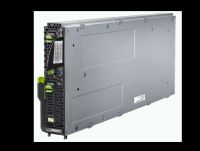Fujitsu unveiled its new generation blade server system this week: Intel Nehalem-based blades, plenty of virtualizationbells and whistles, a host of energy efficiency features via the company’s Cool-safe technology — with the total concept known as the “dynamic cube.” The company is clearly stoked about the potential of the Fujitsu PRIMERGY BX900 and bills it as a complete, out-of-the box dynamic server infrastructure that will take its place as the industry’s most-powerful blade server. To back up these assertions, early benchmarks claim 12 percent more system performance than other blade servers.
Hard-Core Hardware: Fujitsu hones in on blades, unveiling a Nehalem-based blades system offering a host of virtualization bells and whistles as well energy efficiency features delivered via the company’s Cool-safe technology.
What is most interesting is that this machine is in the forefront of the company’s global ambitions, and heralds a more cohesive worldwide presence. Gone is the strangeness of having Fujitsu America for this hemisphere and Fujitsu Siemens for the rest of the world. That joint Siemens branding is over; unified marketing and sales initiatives are the order of the day.
According to Manuel Martull, senior director of server marketing at Fujitsu, blades represent one of the stronger areas for the company in North America. With this new offering, the company plans to double unit sales by the end of 2010 — with a target of 500,000. That kind of expansion would certainly create waves among IBM, HP and Dell.
“With the introduction of the Dynamic Cube, Fujitsu really raises the stakes in the blade market sector,” said Vernon Turner, an analyst at IDC. “The combination of the system’s superior performance, its powerful virtualization capabilities and its power savings add up to make the PRIMERGY BX900 an attractive proposition. We expect to see Fujitsu gain share in the upper segment of the blade server market as a direct consequence of this launch.”
| Fujitsu’s Server Blade |
So what is this Dynamic Cube? The BX900 blade server system is built around Xeon 5500 chips, Fujitsu ServerView Resource Coordinator VE (RCVE) virtualization management software and robust failover capabilities (i.e., software-managed hardware failover). Every active component is hot-swappable.
This 10U chassis can accommodate 18 blades as compared to 14 for IBM and 16 for HP. Other comparisons concerned the airflow and energy usage.
“Other blade enclosures don’t pay enough attention to air inflow and intake,” said Martull. “Yet this area can save you thousands per year per chassis.”
The facia (front of the server) in a comparable IBM system has a grill with only 18 percent of total area allowing air through, said Martull. HP’s facia reaches the mid-20s while Fujitsu has moved further ahead of the others — from 36 percent to 39 percent — by using hexagonal instead of round holes to eliminate more of the metal.
“Other OEMs require very powerful, jet engine-like fans, as they have lower air intake at the front of the server,” said Martull. “Overall, we provide a 30 percent improvement in energy efficiency over competitive offerings.”
In each enclosure, 48 fans are available (i.e., 24 pairs for redundancy). Due to the superior airflow, energy consumption is kept down, as is noise levels. As the air out the back is relatively slow (due to fan speed), it is easier to maintain hot-aisle balance and prevent that air mixing with the cold aisles.
RSVP RCVE
Fujitsu ServerView RCVE management software has the aim of simplifying IT operations by delivering uniform operations for pools of physical and virtual servers. Martull said its automation features can cut provisioning time by up to 90 percent. With VMware VMotion, for example, instead of having to maintain one spare blade for failover purposes per enclosure, RCVE allows you to daisy chain up to four enclosure together with only one failover blade serving all four chassis.
“Similar blade management software can’t do system recovery and failover without human intervention,” said Martull. “RCVE can do it manually or automatically.”
This one tool operates across mixed virtual environments and even across non-Fujitsu hardware. Martull said the software supports HP, Dell and IBM racks or blades. Shipping on May 25, the entry-level price is $10,791. That buys one blade enclosure with one processor blade, a chassis switch and 2 GB RAM plus three power supplies (you can get up to six power supplies if required).


